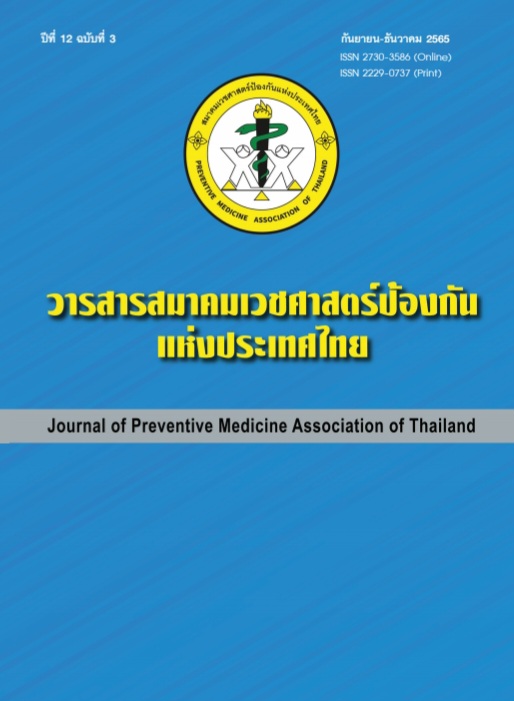Effects of the Physical Activity Promotion Program on the Physical Fitness of Children with Chronic Illness at Sena Hospital, Phra Nakhon Si Ayutthaya
Keywords:
physical activity, physical fitness, chronic illness childrenAbstract
Children and youths aged 5 – 17 years old are the groups that need the most physical activity time compared with other groups, but in the current situation, children aged 12 – 13 years old have insufficient physical activity. The group of children with chronic illness had less physical activity than other groups due to health limitations. Therefore, proper and safe physical activities must be organized by knowledgeable people. The organized activities must be appropriate for the condition of the sick child for each disease group. This study is Quasi-experimental research using One-Group Pretest- Posttest Design. The aim of this study was to compare the physical fitness of chronically ill children before and after receiving the physical activity promotion program. The sample group of children with chronic illnesses aged 3–15 years old consisted of 40 patients that received treatment at Sena Hospital, Phra Nakhon Si Ayutthaya between October 20th, 2019 and March 31st, 2020. The promotion program consisted of educating children on appropriate exercises for them, teaching them to take the pulse, teaching them to count the breaths in one minute, and practicing light exercises such as sit-to-stand, walking, rhythmic dancing, and stretching by allowing parents and public health personnel to participate. In this study, physical fitness was measured eight times with three degrees of activity endurance: low, medium, and high. The results showed that the level of activity tolerance after the program was statistically different from before the program at the .05 level (x2= 22.5608, p = .0001) The suitable physical activity promotion program for chronically ill children with recreational activities influenced the ill children and their parents to cooperate continuously that increased physical performance as measured by activity tolerance. Therefore, it is recommended that the physical activity support program be used in organizing activities for children with chronic illnesses to increase their physical fitness.
References
Wakefield MA, Loken B, Hornik RC. Use of mass media campaigns to change health behavior. Lancet [Internet]. 2010 [cited 2019 Jun 16];376(9748):1261–71. Available from: https://pubmed.ncbi.nlm.nih.gov/20933263/
ดนยา สุเวทเวทิน. ฟิตกิจกรรมทางกาย แข็งแรงสู้โรค [อินเทอร์เน็ต]. 2559 [เข้าถึงเมื่อ 5 พ.ค.2564]. เข้าถึงได้จาก:https://www.thaihealth.or.th/Content.
กองโรคไม่ติดต่อ กรมควบคุมโรค. พฤติกรรมเสี่ยงปัจจัยเสี่ยงโรคไม่ติดต่อ. [อินเทอร์เน็ต]. 2561 [เข้าถึงเมื่อ 5 พ.ค.2564]. เข้าถึงได้จาก: http://www.thaincd.com.
ภูษณิศา มาพิลูน, ปรีย์กมล รัชนกุล, วาริยา หมื่นสา. ผลของโปรแกรมการพัฒนาความสามารถในการดูแลตนเองของเด็กวัยเรียนโรคธาลัสซีเมียและความสามารถในการดูแลเด็กของผู้ดูแล ต่อพฤติกรรมการดูแลตนเองของเด็ก. วารสารสภาการพยาบาล 2559;31(2):52-68.
ประสงค์ เทียนบุญ. ดัชนีมวลกายในกุมารเวชศาสตร์. วารสารโภชนบำบัด 2547;15(3):149-56.
Lee IM, Shiroma EJ, Lobelo F, Puska P, Blair SN, Katzmarzyk PT. Effect of physical inactivity on major non-communicable diseases worldwide: analysis of burden of disease and life expectancy. Lancet [Internet]. 2012 [cited 2020 Mar 19];380(9838):219-29. Available from: https://pubmed.ncbi.nlm.nih.gov/22818936/
International Society for Physical Activity and Health (ISPAH). ISPAH’s eight Investments that work for physical activity [Internet]. 2020 [cited 2021 Jun 19]. Available from: https://www.ispah.org/ resources/key-resources/8-investments/
สิรภพ โตเสม, ธีรนุช ห้านิรัติศัย, ธงชัย สุนทราภา, บวรลักษณ์ ทองทวี. ผลของโปรแกรมการส่งเสริมกิจกรรมทางกายต่อการรับรู้สมรรถนะแห่งตนในการปฏิบัติกิจกรรมทางกาย ความรุนแรงของอาการข้อเข่าเสื่อมและการทรงตัวในผู้ที่มีข้อเข่าเสื่อม. รามาธิบดีพยาบาลสาร [อินเทอร์เน็ต]. 2563 [เข้าถึงเมื่อ 19 มี.ค.2564];26(2):172-87. เข้าถึงได้จาก: https://he02.tci-thaijo.org›download›166534
ปิยะ สินยัง. สมรรถภาพทางกายที่เกี่ยวข้องกับสุขภาพของนักเรียน โรงเรียนมาตรฐานสากล จังหวัดตรัง. วารสารศึกษาศาสตร์ มหาวิทยาลัยสงขลานครินทร์ วิทยาเขตปัตตานี [อินเทอร์เน็ต]. 2557 [เข้าถึงเมื่อ 19 มี.ค.2564];25(3):59-70. เข้าถึงได้จาก: https://he02.tci-thaijo.org ›TNSUJournal
พีรพล บุญญานุวัตร์. สมรรถภาพทางการเพื่อสุขภาพของนักเรียนชั้นมัธยมศึกษาตอนปลาย ในโรงเรียนมัธยมยอดนิยมเขตพื้นที่การมัธยมศึกษาเขต 16 จังหวัดสงขลา. [วิทยานิพนธ์การศึกษามหาบัณฑิต]. สงขลา: มหาวิทยาลัยทักษิณ; 2555.
วายุ แวงแก้ว, สริน ประดู่. การพัฒนารูปแบบกิจกรรมทางกายเพื่อพัฒนาทักษะการประสานงานของกล้ามเนื้อ (ตา-มือ) สำหรับนักเรียนชั้นมัธยมศึกษาปีที่ 2 โรงเรียนสาธิตแห่งมหาวิทยาลัยเกษตรศาสตร์ ศูนย์วิจัยและพัฒนาการศึกษา. วารสารชุมชนวิจัย มหาวิทยาลัยราชภัฎนครราชสีมา [อินเทอร์เน็ต]. 2565 [เข้าถึงเมื่อ 19 มี.ค.2564];16(2):121-34. เข้าถึงได้จาก: https://so04.tci-thaijo.org›NRRU›article›view
Downloads
Published
How to Cite
Issue
Section
License
Copyright (c) 2023 Journal of Preventive Medicine Association of Thailand

This work is licensed under a Creative Commons Attribution-NonCommercial-NoDerivatives 4.0 International License.
บทความที่ลงพิมพ์ในวารสารเวชศาสตร์ป้องกันแห่งประเทศไทย ถือเป็นผลงานวิชาการ งานวิจัย วิเคราะห์ วิจารณ์ เป็นความเห็นส่วนตัวของผู้นิพนธ์ กองบรรณาธิการไม่จำเป็นต้องเห็นด้วยเสมอไปและผู้นิพนธ์จะต้องรับผิดชอบต่อบทความของตนเอง






